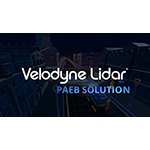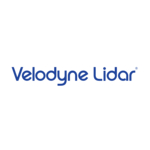Velodyne Lidar Demonstrates How Advanced Lidar Technology Can Improve Pedestrian Safety
New Velodyne Video Illustrates How Lidar-based Pedestrian Automated Emergency Braking System Can Reduce Pedestrian Fatalities in All Conditions
While U.S. Traffic Dropped During the Pandemic, Traffic Fatalities Increased
SAN JOSE, Calif.–(BUSINESS WIRE)–#VelodyneLidar–While overall driving was down 13 percent in miles driven last year due to the COVID-19 pandemic, motor vehicle deaths were up 8 percent in the United States, reported the National Safety Council. Velodyne Lidar, Inc. (Nasdaq: VLDR, VLDRW) today showed how with lidar technology, Pedestrian Automated Emergency Braking (PAEB) systems can be significantly improved, with the potential to save thousands of lives annually.
Velodyne released a new video that showcases how its affordable lidar-based PAEB solution delivers superior performance in all conditions, a decisive advantage over radar+camera-based systems. This is especially critical at night with the National Highway Traffic Safety Administration (NHTSA) reporting 80 percent of pedestrian fatalities occur during dark lighting conditions.
The Velodyne video presents striking test results where a highly-rated PAEB system using radar+camera-based technology failed in all six nighttime scenarios while the Velodyne PAEB solution avoided a crash in every situation. These results support independent testing by NHTSA and the American Automobile Association (AAA) to confirm whether PAEB systems which use radar+camera-based technology adequately protect pedestrians in dark conditions.
The Velodyne PAEB solution combines proprietary software, called Vella, with Velodyne’s lidar sensors. The sensors can be easily embedded in a variety of places around a vehicle, including behind the windshield. Vella software interprets lidar data to avoid and mitigate crashes with moving and static objects. Through predictive collision monitoring, Vella compares a vehicle’s trajectory with other road users and objects to identify and avoid imminent crash scenarios.
Velodyne is sharing the company’s PAEB test methodology and findings with NHTSA and other auto safety leaders. NHTSA has a pending proposal to update its New Car Assessment Program (NCAP), adding advanced driver assistance system (ADAS) capabilities, including PAEB, to the NCAP. Velodyne is very supportive of NHTSA’s NCAP plan to keep pace with evolving safety technologies and providing much-needed information to consumers, and looks forward to NHTSA leadership completing the review of this measure and moving ahead with its request for comment.
“Our PAEB testing initiative clearly demonstrates the imperative for regulatory agencies and testing organizations to include nighttime conditions in their PAEB assessment protocols,” said Anand Gopalan, CEO, Velodyne Lidar. “Everyone, particularly automakers and drivers will expect that ADAS, such as PAEB, perform effectively in a wide variety of lighting situations, particularly at night when the most pedestrian fatalities occur. We believe Velodyne’s lidar data and Vella processing software have shown to be effective and ready for implementation, with the potential to save the lives of thousands of pedestrians annually.”
Velodyne PAEB Testing Methodology
The Velodyne PAEB tests were conducted at nighttime, without streetlights, at less than 1 lux ambient lighting in an independent testing facility. The two vehicles in the test were driving at 30 mph on a straight track. The test vehicles each had their low beam headlights on during the trials. Stationary child and adult pedestrian dummy targets were used, compatible with testing protocols prescribed by Insurance Institute for Highway Safety (IIHS) and Euro NCAP.
Six scenarios were evaluated with both vehicles tested in each scenario five times or until the vehicle collided with the target three times, to minimize damage to the targets and vehicles. The scenarios in which vehicles were evaluated were crossing adult at 50 percent overlap (at the center of the test vehicle’s width); crossing adult at 25 percent overlap; crossing child at 50 percent overlap; crossing child at 25 percent, adult at 75 percent, 10 feet behind child; crossing adult at driver-side corner and fallen adult at 50 percent overlap.
The vehicle with Velodyne’s lidar-based PAEB system, equipped with one Velarray lidar sensor, successfully stopped in time to avoid a crash five out of five times for every scenario tested. The vehicle equipped with a PAEB system using radar+camera-based technology failed in every scenario tested.
Additional details on the Velodyne PAEB testing can be found in a white paper, called “Improving Pedestrian Automatic Emergency Braking (PAEB) in Dark, Nighttime Conditions.”
About Velodyne Lidar
Velodyne Lidar (Nasdaq: VLDR, VLDRW) ushered in a new era of autonomous technology with the invention of real-time surround view lidar sensors. Velodyne is the first public pure-play lidar company and is known worldwide for its broad portfolio of breakthrough lidar technologies. Velodyne’s revolutionary sensor and software solutions provide flexibility, quality and performance to meet the needs of a wide range of industries, including autonomous vehicles, advanced driver assistance systems (ADAS), robotics, unmanned aerial vehicles (UAV), smart cities and security. Through continuous innovation, Velodyne strives to transform lives and communities by advancing safer mobility for all. For more information, visit www.velodynelidar.com.
Forward Looking Statements
This press release contains “forward looking statements” within the meaning of the “safe harbor” provisions of the United States Private Securities Litigation Reform Act of 1995 including, without limitation, all statements other than historical fact and include, without limitation, statements regarding Velodyne’s target markets, new products, development efforts, competition. When used in this press release, the words “estimates,” “projected,” “expects,” “anticipates,” “forecasts,” “plans,” “intends,” “believes,” “seeks,” “may,” “will,” “can,” “should,” “future,” “propose” and variations of these words or similar expressions (or the negative versions of such words or expressions) are intended to identify forward-looking statements. These forward-looking statements are not guarantees of future performance, conditions or results and involve a number of known and unknown risks, uncertainties, assumptions and other important factors, many of which are outside Velodyne’s control, that could cause actual results or outcomes to differ materially from those discussed in the forward-looking statements. Important factors, among others, that may affect actual results or outcomes include changes in laws, regulations or judicial interpretations to which Velodyne or its customers are subject; the uncertain impact of the COVID-19 pandemic on Velodyne’s and its customers’ businesses; Velodyne’s ability to manage growth; Velodyne’s ability to execute its business plan; uncertainties related to the ability of Velodyne’s customers to commercialize their products and the ultimate market acceptance of these products; uncertainties related to Velodyne’s estimates of the size of the markets for its products; uncertainties regarding government regulation and adoption of lidar for pedestrian safety, traffic congestion and smart city applications; the rate and degree of market acceptance of Velodyne’s products; the success of other competing lidar and sensor-related products and services that exist or may become available; Velodyne’s ability to identify and integrate acquisitions; uncertainties related to Velodyne’s current litigation and potential litigation involving Velodyne or the validity or enforceability of Velodyne’s intellectual property; and general economic and market conditions impacting demand for Velodyne’s products and services. Velodyne undertakes no obligation to update or revise any forward-looking statements, whether as a result of new information, future events or otherwise, except as required by law.
Contacts
Investor Relations
Andrew Hamer
Chief Financial Officer
InvestorRelations@velodyne.com
Media
Landis Communications Inc.
Sean Dowdall
(415) 286-7121
velodyne@landispr.com







